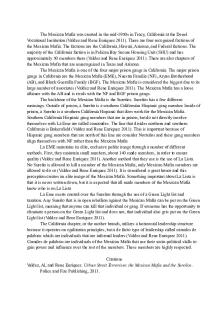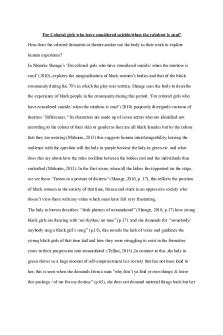Example-Discussion Post PDF

| Title | Example-Discussion Post |
|---|---|
| Author | SIR COBBY |
| Course | Principles of Business Management |
| Institution | University of the People |
| Pages | 3 |
| File Size | 86.3 KB |
| File Type | |
| Total Downloads | 7 |
| Total Views | 168 |
Summary
Download Example-Discussion Post PDF
Description
UoPeople Discussion Response Examples
Note: This is an example discussion forum response. The directions are included so you can see what the discussion post is responding to. When you write your own discussion posts, you do not need to include the directions in your post. (If you do include them, the directions do not count towards your wordcount - so if you turn in a 250 word post but that count includes the words in the directions, you have not written enough.)
Directions: What are the benefits of collaborative learning? How does University of the People integrate community-oriented learning into the classroom? In your response, be sure to share any experience you have with collaborative learning. Your response should be at least 250 words.
Example response (Excellent):
Collaborative learning is a way of learning with others so that a group builds knowledge together. This brings many benefits, but one of the most important benefits is that learning as a community is more social. When students learn as a community, they improve their communication skills and enrich their own learning through the diversity of the community (University of the People, n.d.). Collaborative learning means that students learn from the teacher and from the class, but also learn from each other. Because students bring such diverse perspectives, this means students actually learn more when they learn from each other.
University of the People (UoPeople) integrates community-oriented learning throughout theprocess. Most noticeably, learners participate in community learning through the discussion forum. In the discussion forum, students share their insight and other students read and reply. Students learn initially from the class readings and writing their post, but then learn more through other student posts and conversation with other students. However, the discussion forum is not the only communal aspect of learning at UoPeople. In some classes students have the opportunity to participate in group projects, where groups work together to produce an assignment. And in every class, students participate in peer assessment, where they actively read and provide constructive criticism to help other students grow.
Personally, collaborative learning has not been evident in previous educational experiences. While high school occasionally had group projects, a lot of high school learning is in the form of teacher lectures and reading books. Quite honestly in high school group projects were not a lot of un because a lot of times students were not motivated to do the work - they knew someone else in the group would. But more importantly in high school students are not encouraged to become a community of learners like they are here. Hopefully discussions and peer assessments will be a far more effective way to learn together than high school projects were!
Word count: 325 References: University of the People. (2018). Collaborative and peer to peer learning. Retrieved from https://www.uopeople.edu/student-experience/quality/collaborative-peer-peer-learning/
Example response (Average):
Collaborative learning helps students learn by learning together. By building a community we can learn from each other and work to learn the material better. By learning from each other, we learn new stuff that we might not have found ourselves by only reading our textbook. Talking different points through helps us understand things we might not otherwise understand. Sharing ideas helps us grow and learn from our mistakes, too.
Collaborative learning also builds social skills because we have to interact with each other and communicate more often. This means we’re not just writing down our thoughts for the teacher and moving on. By learning through interacting, we also improve our ability to work as a group. This is important because on the job most of us will need to work with our coworkers, so we need good communication skills. This is especially true when learners come from all different areas and cultures, because we learn to communicate with people who have different backgrounds.
UoPeople uses collaborative learning in two big ways. We collaborate in the discussion forum by talking through the topic and we collaborate on writing when we peer assess. In these ways we work together and we learn from each other.
I have not had much experience with collaborative learning but I have worked with coworkers to work on projects. That involves a lot of learning and learning from and with each other. As much as working in a group can be frustrating, we definitely got work done better as a group than we did on our own. I can see why collaborative learning might have the same benefits as working as a group.
Word count: 277
Example response (Below Average):
Collaborative learning is when you learn together. It’s good because when you learn as a group you come together as a group. This makes good social connections and good udnerstanding. More brains means more work and more learning.
UoPeople uses collaborative learning in discussion where we talk an learn from each other. You meet new people here from all around the world! We also get collaborative learning when we collaborate to learn on criticing written assignments. We also help each other when we have questions.
I collaborated in group projects in high school. When I had trouble understanding it was good to have classmates to talk to to help undersntand.
Word count: 110...
Similar Free PDFs

Post lab - Post Lab 1
- 2 Pages

Discussion Post
- 1 Pages

Post lab 10 - Post lab 10
- 3 Pages

Discussion Post
- 2 Pages

Week 2 Post - Week 2 Post
- 1 Pages

Post lab 2 - post lab orton
- 8 Pages

Post task Angie Mora - Post tarea
- 14 Pages

Post lab 3 - post lab orton
- 13 Pages

Post4 - post
- 2 Pages

Journal Post
- 3 Pages

Blog post #2 - post 2 online
- 1 Pages
Popular Institutions
- Tinajero National High School - Annex
- Politeknik Caltex Riau
- Yokohama City University
- SGT University
- University of Al-Qadisiyah
- Divine Word College of Vigan
- Techniek College Rotterdam
- Universidade de Santiago
- Universiti Teknologi MARA Cawangan Johor Kampus Pasir Gudang
- Poltekkes Kemenkes Yogyakarta
- Baguio City National High School
- Colegio san marcos
- preparatoria uno
- Centro de Bachillerato Tecnológico Industrial y de Servicios No. 107
- Dalian Maritime University
- Quang Trung Secondary School
- Colegio Tecnológico en Informática
- Corporación Regional de Educación Superior
- Grupo CEDVA
- Dar Al Uloom University
- Centro de Estudios Preuniversitarios de la Universidad Nacional de Ingeniería
- 上智大学
- Aakash International School, Nuna Majara
- San Felipe Neri Catholic School
- Kang Chiao International School - New Taipei City
- Misamis Occidental National High School
- Institución Educativa Escuela Normal Juan Ladrilleros
- Kolehiyo ng Pantukan
- Batanes State College
- Instituto Continental
- Sekolah Menengah Kejuruan Kesehatan Kaltara (Tarakan)
- Colegio de La Inmaculada Concepcion - Cebu




